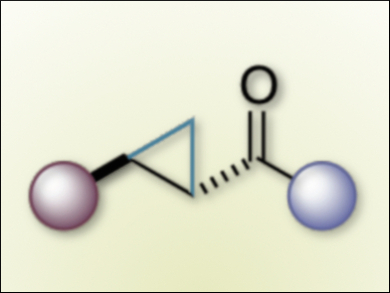Cyclopropane rings can be found in a large variety of secondary metabolites with diverse biological activities. This has contributed to their importance in medicinal and agricultural chemistry. The synthesis of cyclopropanes can be achieved by using different catalytic processes involving iodomethylzinc carbenoids, diazomethane, and sulfur or nitrogen ylides. Interestingly, methods based on radical species are still scarce.
Ana M. del Hoyo and Marcos García Suero, Institute of Chemical Research of Catalonia (ICIQ), Tarragona, Spain, have developed a cyclopropanation reaction of Michael-acceptor compounds. The reaction uses diiodomethane as a methylene-transfer reagent and the Ru-based photoredox catalyst [Ru(bpy)3](PF6)2 (bpy = 2,2’-bipyridine). The reaction proceeds via an iodomethyl radical carbenoid, which is generated photocatalytically and subsequently cyclopropanates the alkene group of Michael-acceptor compounds.
The reaction tolerates a large variety of differently substituted chalcones and heteroaryl analogues. α,β-Unsaturated aldehydes or methyl ketones are also converted. Interestingly, 1,1-diodoethane can also be used as a methylene source in a selective manner.
- Photoredox-catalyzed Cyclopropanation of Michael Acceptors,
Ana M. del Hoyo, Marcos García Suero,
Eur. J. Org. Chem. 2017.
DOI: 10.1002/ejoc.201601604




